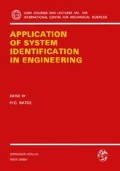Abstract
Large steam turbine-generators in operation may be stimulated to torsional vibrations by dynamic moments at the generator due to electrical system transients, Fig. 1. The induced torsional stresses have grown growing attention over the past few years /1–3/.
Access this chapter
Tax calculation will be finalised at checkout
Purchases are for personal use only
Preview
Unable to display preview. Download preview PDF.
References
Berger, H., Kulig, T.S.: Simulation Models for Calculating the Torsional Vibrations of Large Turbine-Generator Units after Electrical System Faults, Siemens Forschungs-und Entwicklungsberichte, Band 10, 1981, Nr. 4.
Schwibinger, P.: ‘Torsionsschwingungen von Turbogruppen und ihre Kopplung mit den Biegeschwingungen bei Getriebemaschinen’, PhD-Thesis, Univ. Kaiserslautern, 1986.
IEEE Comitee Report: ‘A Bibliography for the Study of Subsynchronous Resonance between Rotating Machines and Power Systems’, IEEE Trans., Vol. PAS-95, 1976.
Schwibinger, P.; Feng, T., Nordmann, R.: ‘Improvement of a Reduced Torsional Model by means of Parameter Identification’, Intl. Conf. on Rotordynamics–IFTOMM and JSME, Tokyo, Sept. 14–17, 1986.
Bethke, J.: ‘Reduktion der Freiheitsgrade von kettenförmigen Torsionsschwingungssystemen mit elektrischen Analogiemodellen’, Master Thesis, Univ. Kaiserslautern, 1985 (unpublished).
Di, Than Nguyen: ‘Beitrag zur Reduktion diskreter Schwingerketten auf ein Minimalmodell’, PhD-Thesis, Univ. Dresden, 1974.
Zimmermann, H., Collmann, D., Natke, H.G.: Erfahrungen zur Korrektur des Rechenmodells mit gemessenen Eigenfrequenzen am Beispiel des Verkehrsflugzeuges VFW 614, Zeitschrift für Flugwissenschaften und Weltraumforschung 1 (1977), Heft 4.
Natke, H.G.: Einführung in Theorie und Praxis der Zeitreihen-und Modalanalyse, Vieweg-Verlag, Braunschweig, Wiesbaden, 1983.
Author information
Authors and Affiliations
Editor information
Editors and Affiliations
Rights and permissions
Copyright information
© 1988 Springer-Verlag Wien
About this chapter
Cite this chapter
Schwibinger, P., Nordmann, R. (1988). Optimization of a Reduced Torsional Model Using a Parameter Identification Procedure. In: Natke, H.G. (eds) Application of System Identification in Engineering. International Centre for Mechanical Sciences, vol 296. Springer, Vienna. https://doi.org/10.1007/978-3-7091-2628-8_16
Download citation
DOI: https://doi.org/10.1007/978-3-7091-2628-8_16
Publisher Name: Springer, Vienna
Print ISBN: 978-3-211-82052-0
Online ISBN: 978-3-7091-2628-8
eBook Packages: Springer Book Archive

